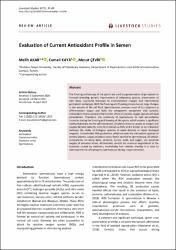Evaluation of current antioxidant profile in semen
Künye
AKAR M, KAYA C, ÇEVİK M (2021). Evaluation of Current Antioxidant Profile in Semen. Livestock studies, 61(1), 37 - 45. 10.46897/livestockstudies.610106.Özet
The freezing and storage of the sperm are used cryopreservation of germplasm in livestock breeding, genetic improvement of indigenous species, preservation of rare races, successful tolerance to environmental changes and international germplasm exchanges. Both the freezing and thawing process causes large changes in the volume of the cell fluid. Spermatozoon removes most of its cytoplasm at differentiation stages and lacks the cytoplasmic component that contains antioxidants that counteract the harmful effect of reactive oxygen species and lipid peroxidation. Therefore, the sensitivity of spermatozoa to lipid peroxidation increases during the freezing and thawing of the sperm, which creates a significant mechanical stress on the cell membrane. Oxidative stress is caused by oxygen and oxygen-derived oxidants, commonly known as ROS, and is known as an imbalance between the ability of biological systems to easily detoxify or repair damaged reagents. Uncontrolled ROS production, which exceeds the antioxidant capacity of seminal plasma, causes oxidative stress that is harmful to spermatozoa. All cellular components, including lipids, proteins, nucleic acids, and sugars, are potential targets of oxidative stress. Antioxidants control the chemical degradation of the substrate caused by oxidation, neutralizing free radicals, thereby it is used to minimize the risk of damage to spermatozoa during cryopreservation.
















